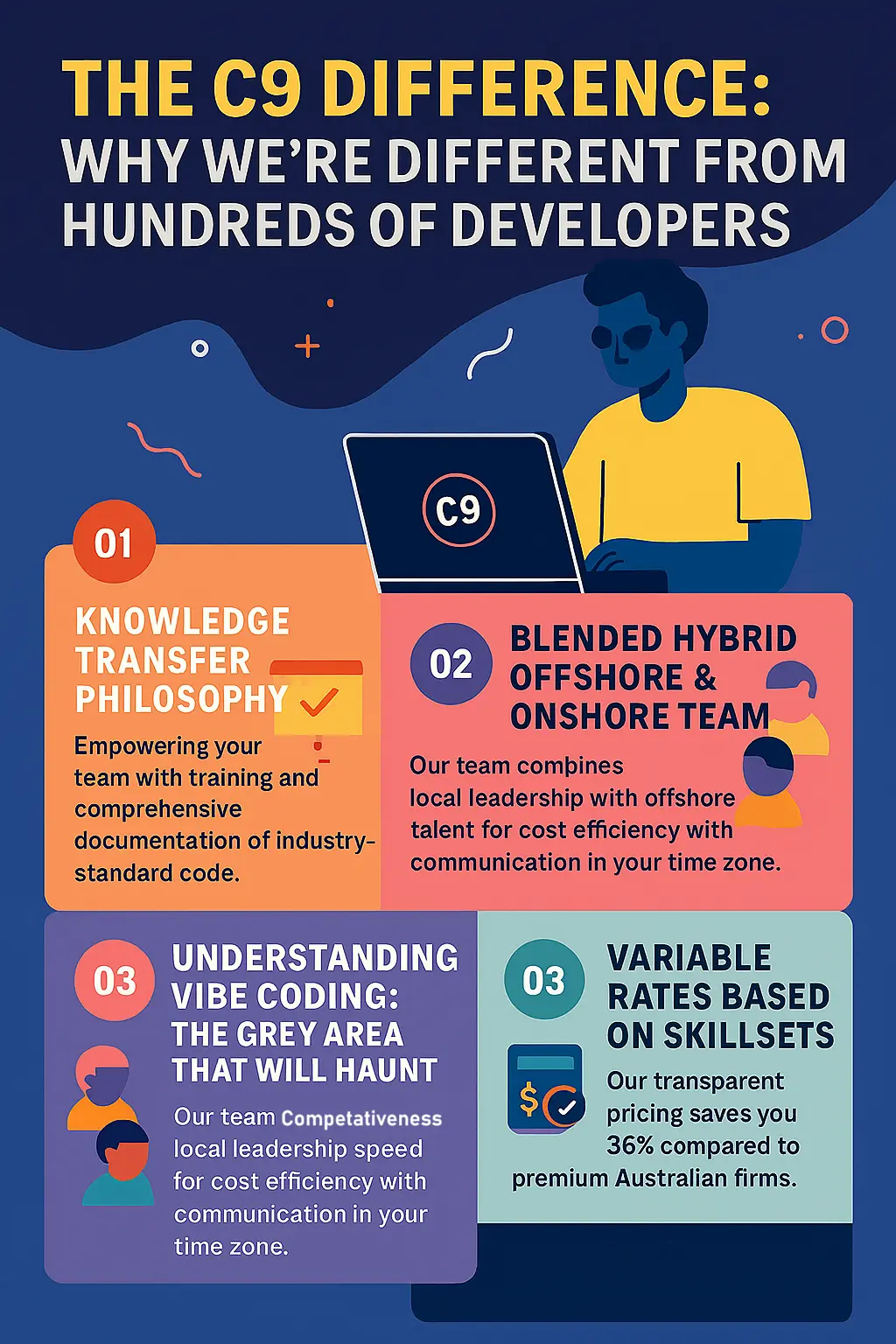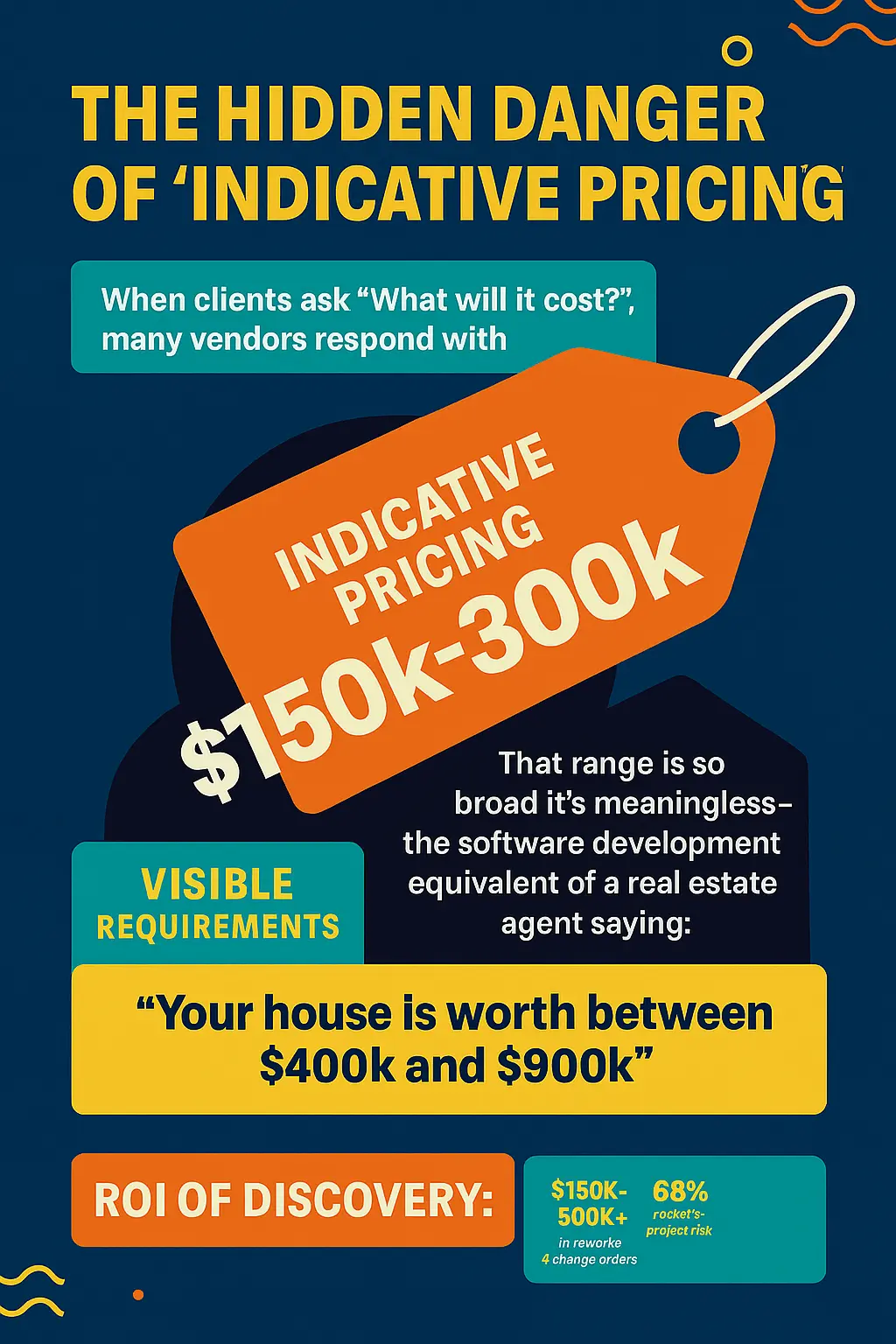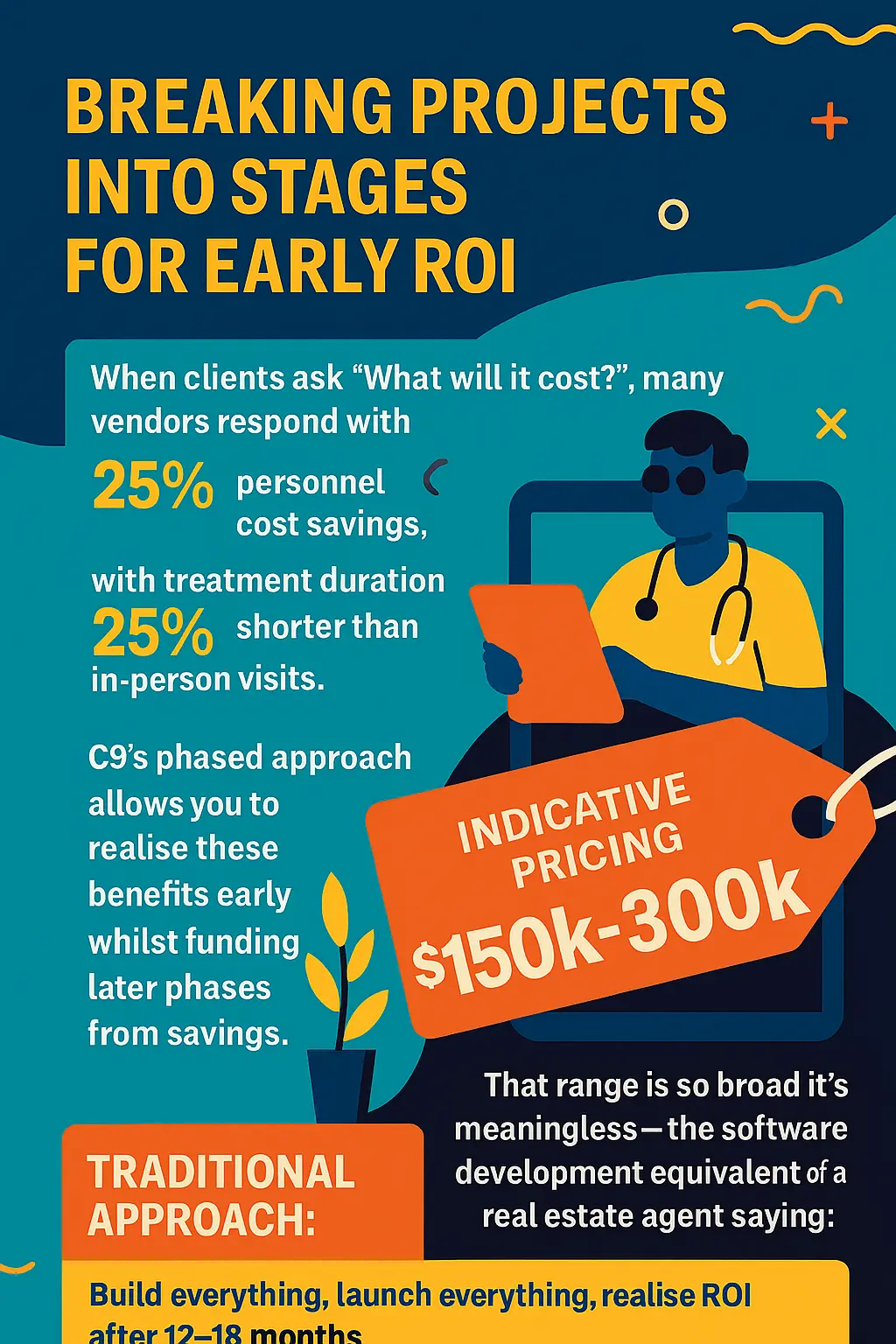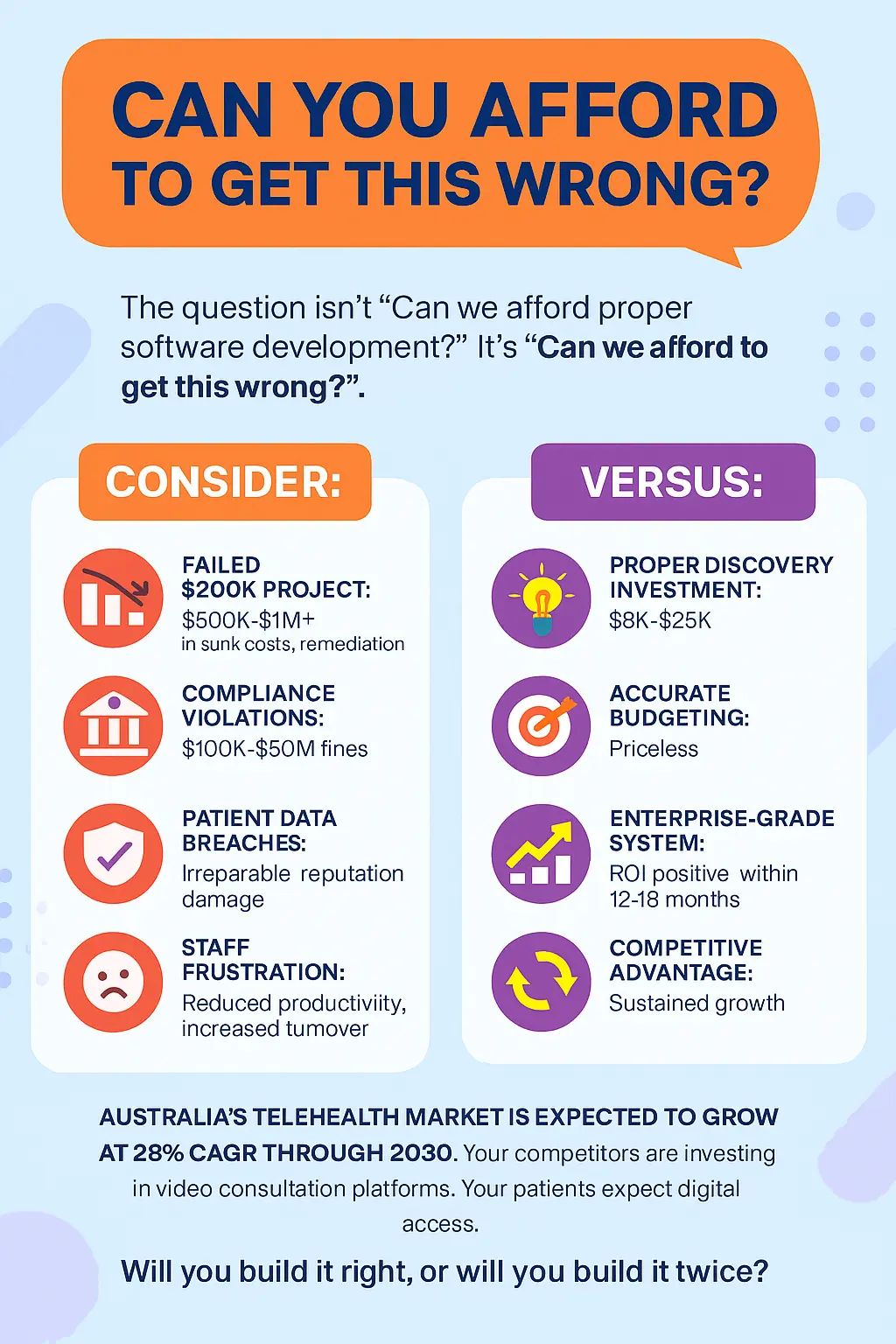The Australian telehealth market is experiencing unprecedented growth, projected to reach USD 21.8 billion by 2030 with a 28% compound annual growth rate. Yet beneath these promising figures lies a sobering reality: 73% of healthcare organisations experience significant issues with video consultation platforms within the first 18 months due to poor planning and rushed implementation.
If you're a healthcare business owner or executive considering consultation software development for medical consultation services, this guide reveals what you must know before investing—and why the cheapest option often becomes the most expensive mistake.
The High-Stakes Reality of Healthcare Software Development

When healthcare data breaches compromised over 275 million records in 2024, the message became clear: video consultation platforms aren't just convenient tools—they're critical infrastructure that demands enterprise-grade security, compliance, and reliability.
In Australia, where telehealth adoption in hospitals rose from 20% to 85% during the COVID-19 pandemic, the pressure to implement video consultation platforms quickly is immense. However, this urgency has created a dangerous trend: healthcare organisations making costly decisions based on incomplete information, low-ball quotes, and unrealistic promises.
The Three Critical Mistakes Healthcare Executives Make

Mistake #1: The "We Need It Yesterday" Syndrome
The Painful Reality:
- Executive pressure to launch immediately to compete with rivals
- Board members comparing your facility to tech startups that "built apps in weekends"
- Fear of being left behind whilst competitors offer telehealth services
Research shows rushed implementations result in 73% project failure rates in healthcare IT, with the average cost of failed healthcare software projects ranging from $1.2M to $8.5M. Add compliance violations from poorly architected systems—HIPAA fines range from $100K to $50M—and the stakes become devastatingly high.
Real Example: A Melbourne private hospital rushed into a $400K video consultation platform without proper discovery. Within six months, the platform couldn't integrate with their 15-year-old EMR system, had no Business Associate Agreement in place (a compliance nightmare), and received patient complaints about privacy and connection quality. Total sunk cost: $627K including attempted fixes. They eventually scrapped everything and started over with proper planning.
Mistake #2: Choosing Vendors Based on Price, Not Value
Studies show video consultations can save 25% in personnel costs and increase the number of treatable patients by 172 annually, but these savings evaporate when cheap solutions create more problems than they solve.
Cost Comparison Reality:
| Solution Type |
Advertised Cost |
Actual 3-Year TCO |
| Consumer Platform (Healthcare) |
$15/user/month |
$180K - $350K |
| Off-the-Shelf Healthcare Platform |
$50K - $150K upfront |
$280K - $550K |
| Custom Development (Done Wrong) |
$200K - $400K |
$800K - $2M (rework) |
| Custom Development (Done Right) |
$250K - $500K |
$450K - $750K |
The "cheap" solutions lack essential healthcare features: EHR integration, clinical documentation, specialty workflows, and proper compliance frameworks.
Mistake #3: Underestimating Technical Complexity
"How hard can it be? It's just video calling, right?" This dangerous assumption ignores that healthcare video consultation platforms require:
✅ End-to-end encryption (TLS 1.3+, AES-256)
✅ HIPAA/Privacy Act 1988 compliance documentation
✅ Business Associate Agreements with all vendors
✅ Role-based access controls for multi-disciplinary teams
✅ Audit logs tracking every access to patient data
✅ EHR/EMR integration via HL7 FHIR or proprietary APIs
✅ Clinical workflow customisation for different specialties
✅ Multi-factor authentication and session management
✅ Disaster recovery and business continuity planning
Australian-specific requirements include Privacy Act compliance, My Health Record integration capabilities, Medicare billing integration for telehealth item numbers, and state-based health department reporting requirements.
The Hidden Crisis: AI Cowboys and Vibe Coding

A new breed of "developers" has emerged—those who use AI tools like ChatGPT or Claude to generate entire applications without understanding the underlying code. They promise to "build your entire platform in two weeks for 70% less than traditional developers."
Recent analysis of 211 million lines of AI-generated code revealed a 20% error rate, 8x increase in duplicated code blocks, and 73% of AI-coded projects accumulating severe technical debt within six months.
Understanding Vibe Coding: The Grey Area That Will Haunt You
"Vibe coding" means relying on AI to generate code from vague natural-language prompts without truly understanding the output. The developer "vibes" with the AI, accepting code that "seems to work" without rigorous testing or architectural planning.
Why It's Catastrophic for Healthcare:
1. Security Vulnerabilities Multiply AI generates code based on patterns, not security best practices. In one real incident, an AI-generated telehealth platform had a critical vulnerability where patient session tokens were stored in browser localStorage without encryption. A single XSS attack could have compromised thousands of patient records. The "developer" didn't understand the security implications because they didn't write the authentication system—the AI did.
2. Compliance Nightmares AI doesn't understand HIPAA, Privacy Act, or healthcare regulations. Audit trails are incomplete or improperly implemented, data retention policies violate regulatory requirements, and there's no documentation trail for compliance audits.
3. Technical Debt Time Bombs Code that "works now" but can't be maintained or scaled creates the "mystery code" problem. When vibe-coded systems break (and they will), no one can fix them—including the original "developer."
Case Study: The $80K Platform That Cost $650K
A Sydney healthcare group hired a freelancer offering "AI-powered rapid development" at $80,000—significantly cheaper than established firms ($250K - $400K).
What Happened:
Months 1-3 (The Honeymoon): Platform delivered "on time," basic video calls worked, clean-looking interface.
Month 4 (Cracks Appear): Platform crashed with 10+ concurrent users, video quality deteriorated unpredictably, no integration with existing practice management system.
Month 6 (The Unravelling): Security audit revealed 43 critical vulnerabilities, no HIPAA-compliant audit trails, patient data stored unencrypted in cloud database, Privacy Act violations discovered.
Month 8 (The Reckoning): Platform deemed "unsalvageable" by independent audit, complete rebuild required.
Final Tally:
- Original "cheap" platform: $80,000
- Emergency fixes and patches: $95,000
- Compliance audit and legal: $87,000
- Complete rebuild with proper firm: $388,000
- Total cost: $650,000 (8.1× the "bargain" price)
- Opportunity cost: 14 months of delayed telehealth services
The Lesson: The "savings" from cheap development evaporated into a financial disaster that cost more than double what proper development would have cost initially.
Why Discovery Calls Are Non-Negotiable
.webp)
Research from the Standish Group shows 68% of software projects that skip discovery phase fail or require major rework, with average cost overruns of 3.5× the original estimate and timeline overruns of 2.8× the planned duration.
What Discovery Calls Actually Accomplish
When executives say "we need a video consultation platform," they're describing the tip of an enormous iceberg. Discovery uncovers the hidden requirements that determine success or failure.
Visible Requirements (What Clients Usually Mention):
- Video calling between doctor and patient
- Schedule appointments
- Basic patient information
Hidden Requirements (Discovered in Discovery):
- Clinical Workflows: How do different specialties differ? What happens during consultation escalations? How do you handle patients with limited English?
- Integration Complexity: Which EMR system? Practice management software? Pathology/radiology image viewing? Medicare billing?
- Compliance Specifics: What PHI is transmitted? Where is data stored? (Australian data sovereignty) Who needs access?
- User Experience Variables: Patient demographics? Mobile vs desktop usage? Accessibility needs? Multilingual requirements?
Real Example: A Brisbane clinic requested a "simple video consultation platform." Discovery revealed they had three different EMR systems across four locations, 35% of patients were over 70 (needed simplified interface), 20% of consultations were mental health (required different privacy protocols), and they needed integration with two different pathology providers.
Without discovery: Initial estimate $180K, five months
After discovery: Accurate estimate $420K, nine months
With discovery, they could make informed budget decisions, phase the rollout, plan for proper change management, and avoid the "bait and switch" feeling of constant change orders.
How C9's Discovery Process Works (2-4 Weeks)
Week 1: Stakeholder Workshops Solution architects and healthcare domain experts meet with your executive team, clinical leads, and IT managers to understand business objectives, current state assessment, future vision, and regulatory requirements.
Week 2: Technical Deep-Dive Technical architects assess current infrastructure, integration requirements, security and compliance needs, and third-party dependencies.
Week 3: User Research & Workflow Mapping Business analysts and UX researchers shadow clinical staff, interview patients about technology comfort, map workflows, and identify specialty-specific requirements.
Week 4: Solution Design & Estimation The full team synthesises findings into comprehensive solution architecture, feature prioritisation, risk analysis, and detailed cost/timeline estimation.
Discovery Investment:
- Small Project (<$200K): $8K-12K
- Medium Project ($200K-500K): $15K-25K
- Large Project (>$500K): $30K-50K
ROI of Discovery: Prevents $150K-500K+ in rework and change orders, reduces project risk by 68%, improves on-time delivery by 83%, and increases stakeholder satisfaction by 91%.
The C9 Difference: Why We're Different from Hundreds of Developers

1. Knowledge Transfer Philosophy
Unlike vendors who create dependency, C9 believes in empowering your team through comprehensive documentation, code ownership (you own 100% of the code), team training to maintain and extend systems, and technology choices using industry-standard, widely-supported technologies.
When the system is yours—truly yours—you're not held hostage to a single vendor for every update, fix, or feature enhancement.
2. Blended Hybrid Offshore & Onshore Team Model
C9 operates a unique blended team structure combining Australian-based senior architects and project managers (onshore) with specialised developers and engineers (offshore—directly hired, not outsourced), unified team culture with Australian business hours overlap, and single accountability.
Why This Model Works:
| Aspect |
Pure Australian |
Pure Offshore |
C9 Hybrid |
| Cost |
$150-250/hour |
$25-60/hour |
$85-140/hour |
| Communication |
Excellent |
Challenging |
Excellent |
| Quality |
High |
Variable |
High |
| Timezone |
Perfect |
Difficult |
Optimised |
Key Benefits:
- ✅ Cost Efficiency: 40-60% savings vs all-Australian teams
- ✅ Seamless Communication: Australian team members in your timezone
- ✅ 24-Hour Development: Offshore team progresses work whilst you sleep
- ✅ Consistent Quality: C9-hired talent with unified processes
- ✅ Scalability: Expand team quickly without local recruitment challenges
Important: C9 does NOT use in-house local hiring in Australia for augmented staff. We are remote-first. All collaboration happens via modern communication tools with scheduled meetings during business hours.
3. Variable Rates Based on Skillsets
Unlike firms charging $150-200/hour regardless of who's working, C9 rates reflect actual skill requirements:
C9 FY25/26 Rates (Subject to CPI adjustments)
| Role Level |
Blended Rate |
| Junior Developer |
$65-85/hour |
| Mid-Level Developer |
$90-115/hour |
| Senior Developer |
$120-145/hour |
| Architect/Tech Lead |
$150-180/hour |
| Project Manager |
$150-180/hour |
Cost Savings Example: Building a video consultation platform requiring 1,900 hours over six months:
- Premium Australian Firm: $342,000 ($180/hour all roles)
- C9 Blended Model: $217,500 (variable by role)
- Savings: $124,500 (36%)
The Hidden Danger of "Indicative Pricing"

When clients ask "What will it cost?", many vendors respond with "indicative pricing of $150K-300K." That range is so broad it's meaningless—the software development equivalent of a real estate agent saying "Your house is worth between $400K and $900K."
Why Indicative Pricing Fails
Indicative pricing is estimated to: The nearest week (±5 days) or month (±20 days)
Discovery-based pricing is estimated to: The nearest day (±1 day) or few hours for specific features
Example:
Indicative Estimate: "Video consultation platform: 12-20 weeks, $180K-320K" (variance: $140K or 78%)
Discovery-Based Estimate: "Video consultation platform: 1,725 hours ± 80 hours, $245K ± $18K" with detailed module breakdown showing exactly where every hour and dollar goes.
Real-World Comparison
Vendor A (Indicative Pricing): Initial quote: $180K-280K, five to seven months
Actual outcome: $400K, nine months (122% over low estimate)
Relationship: Severely damaged
C9 (Discovery-Based Pricing): Discovery investment: $18K
Final estimate: $388K, 10 months
Actual outcome: $388K, 11 months (0% variance, one-month delay due to client approval)
Relationship: Excellent, referral provided
Breaking Projects into Stages for Early ROI

Research shows video consultations deliver 25% personnel cost savings, with treatment duration 25% shorter than in-person visits. C9's phased approach allows you to realise these benefits early whilst funding later phases from savings.
Traditional Approach: Build everything, launch everything, realise ROI after 12-18 months
C9 Phased Approach:
Phase 1 (Months 1-4): Core Platform - $168K
- Launch basic video consultations
- Month 5 onwards: $8K/month savings
Phase 2 (Months 6-9): Multi-Specialty - $126K
- Funded partially by Phase 1 savings ($32K accumulated)
- Month 10 onwards: $15K/month savings
Phase 3 (Months 10-13): Mobile & Advanced - $94K
- Funded by accumulated savings ($60K)
- Month 14 onwards: $22K/month savings
Financial Comparison at Month 16:
- Traditional approach: -$312K
- C9 phased approach: +$52K (break-even passed)
Staff Augmentation: Flexibility That Works

C9 offers three staff augmentation models:
Monthly Rolling Contract: Month-to-month, 30-day termination notice, standard rates
3-Month Minimum: 8% discount off standard rates
6-Month Minimum: 15% discount (20% for 3+ resources)
Why 3-6 Month Minimums Benefit Clients
Resource Stability: Top developers won't take uncertain engagements—3-6 months attracts senior talent
Productivity Efficiency: Ramp-up cost amortised over longer period
Knowledge Retention: Long enough to complete meaningful work and document
Cost Savings: $50K-150K+ savings on typical projects
Project Success: 78% completion rate vs 34% for month-to-month
C9 offers individual developer augmentation, pod augmentation (3-5 people), and full team augmentation (6+ people) with integrated quality assurance, no single-developer knowledge silos, and team accountability.
Making the Decision: Your Next Steps

The choice before Australian healthcare organisations is clear: invest in proper consultation software development for medical consultation services with experienced partners, or risk joining the 73% of failed implementations.
The C9 Engagement Process
Step 1: Initial Consultation (Free, 45-60 minutes) Honest assessment of your needs, rough order of magnitude estimate, discovery process discussion—no obligation, no pressure.
Step 2: Discovery Phase 2-4 weeks of comprehensive analysis delivering detailed requirements, technical architecture, risk analysis, and accurate estimates (±5-10%).
Step 3: Project Execution Phased implementation with regular sprints, transparent progress tracking, and ongoing communication.
What Separates C9
| Factor |
Typical Vendors |
AI Cowboys |
C9 |
| Discovery |
Optional |
Skipped |
Mandatory |
| Pricing |
Indicative |
Low-ball |
Discovery-based |
| Knowledge Transfer |
Minimal |
None |
Comprehensive |
| Team Structure |
All onshore/offshore |
Solo |
Hybrid blended |
| Code Ownership |
Vendor lock-in |
Abandoned |
Full ownership |
Conclusion: Can You Afford to Get This Wrong?

The question isn't "Can we afford proper software development?" It's "Can we afford to get this wrong?"
Consider:
- A failed $200K project costs $500K-1M+ in sunk costs and remediation
- Compliance violations: $100K-$50M in fines
- Patient data breaches: Irreparable reputation damage
- Staff frustration: Reduced productivity, increased turnover
Versus:
- Proper discovery investment: $8K-25K
- Accurate budgeting: Priceless
- Enterprise-grade system: ROI positive within 12-18 months
- Competitive advantage: Sustained growth
Australia's telehealth market is expected to grow at 28% CAGR through 2030. Your competitors are investing in video consultation platforms. Your patients expect digital access.
Will you build it right, or will you build it twice?
Take Action Today
✅ Honest assessment of your video consultation platform needs
✅ Rough order of magnitude estimate
✅ Discovery phase proposal tailored to your situation
✅ No-pressure conversation with experienced healthcare software architects
About C9
C9 is Australia's leading custom software, apps, integration, and database developer, specialising in healthcare technology solutions. With a unique hybrid offshore-onshore model, C9 delivers enterprise-grade consultation software development for medical consultation services at sustainable costs whilst maintaining Australian quality standards and communication excellence.